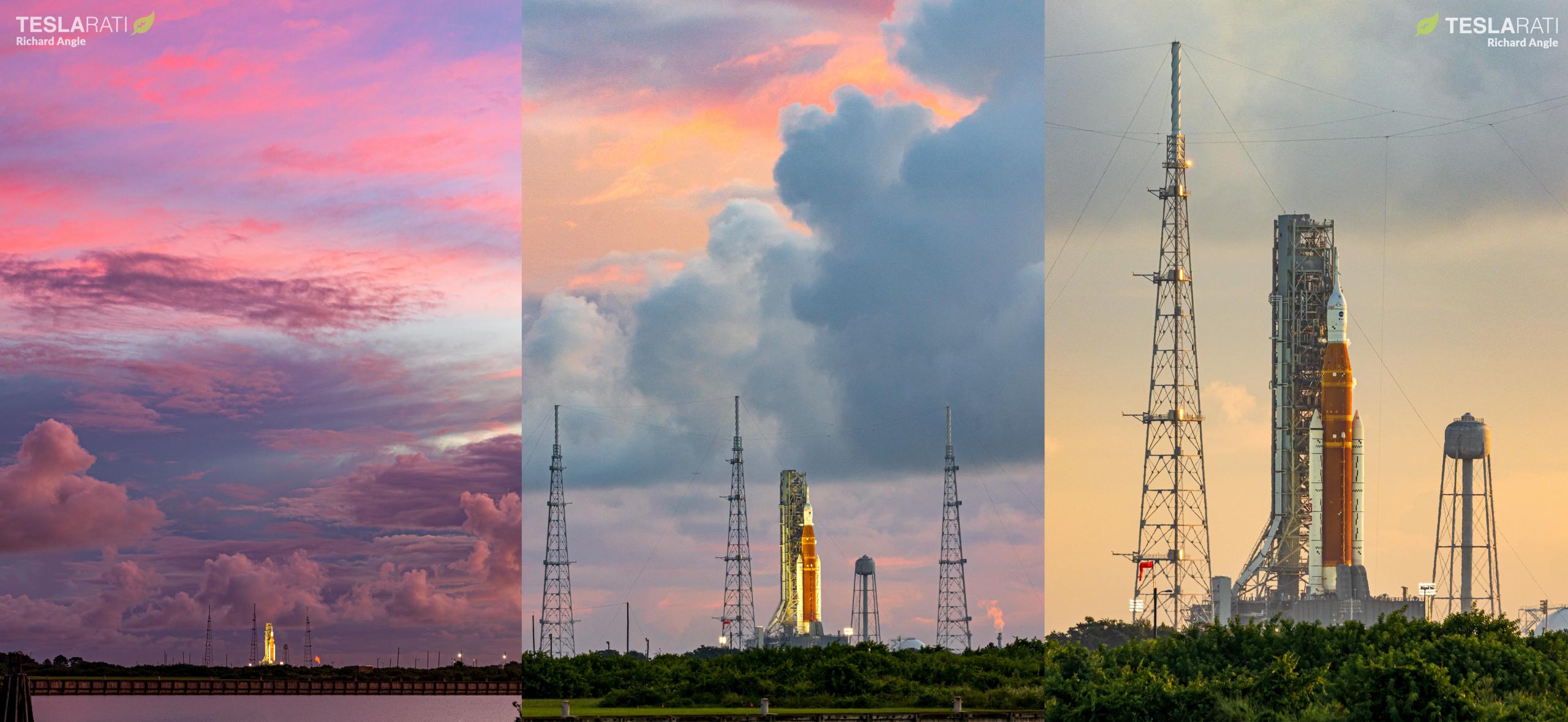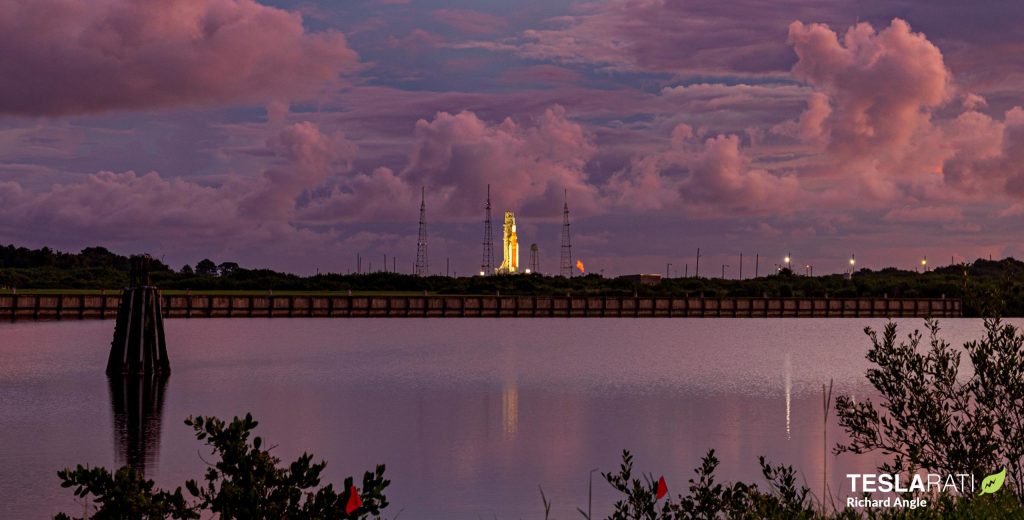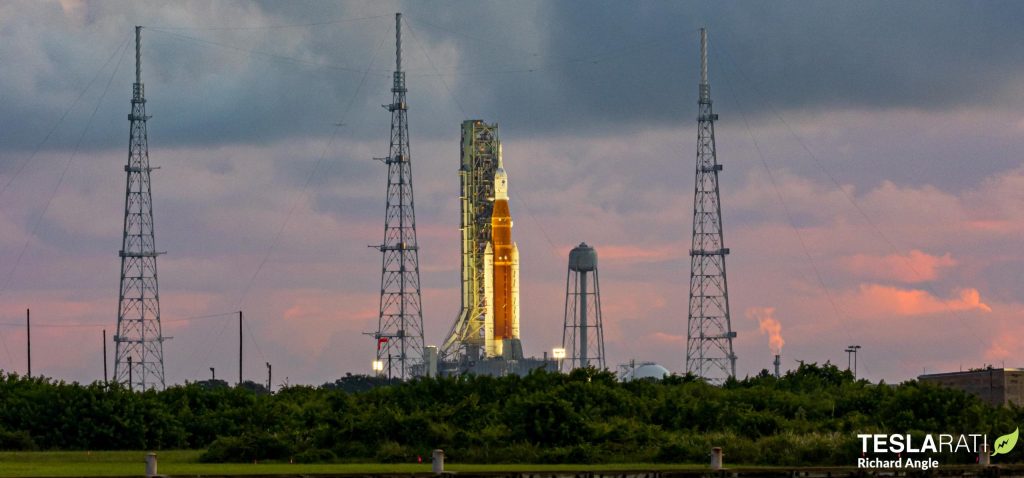

News
NASA scrubs first SLS Moon rocket launch attempt
NASA has scrubbed the first attempted launch of its Space Launch System (SLS) Moon rocket after running into multiple issues, one of which could not be solved in time.
The delay is bad news for the tens to hundreds of thousands of tourists who traveled to Cape Canaveral, Florida to witness the launch in person. Worse, by NASA’s own implicit admission, there’s a good chance the main problem SLS encountered could have already been dealt with and rectified in advance of the launch attempt if the space agency had finished testing the rocket earlier this summer.
Ultimately, that omission turned the first SLS launch attempt into more of a continuation of the rocket’s first four wet dress rehearsal (WDR) attempts, none of which ended as expected. NASA engineers will now have to decide how to proceed and whether the SLS rocket can be made ready in time for another launch attempt on September 2nd or 5th. If not, the next opportunity could be weeks away.
As far as SLS test operations go, the August 28/29th launch attempt was fairly ordinary, with the rocket running into multiple issues – a few minor, a few significant, and one identical to a previous problem. The first problem – a hydrogen leak near the SLS rocket’s base – came after a risk of lightning delayed the start of propellant loading by more than an hour. A very similar, if not identical, hydrogen fuel leak had already occurred during official wet dress rehearsal testing in April and July.
That leak was fixed on the fly by properly chilling all related systems, and propellant loading was eventually completed – albeit a few hours late thanks to inclement weather. Shortly after, there were reports of a crack that needed careful analysis. Only later did NASA specify that the suspected crack was in the rocket’s foam insulation rather than its structures, the latter of which could have been a catastrophic problem.
Around the same time, the true showstopper of the day occurred when NASA attempted to chill the SLS Core Stage’s four RS-25 engines, all of which flew several times aboard reusable Space Shuttle orbiters. Three engines performed (mostly) as expected, flowing a bit of liquid hydrogen fuel to cool themselves down, but one – engine #3 – was never able to make progress toward the optimal temperature needed for ignition (~5°C/~41°F). After hours of remote troubleshooting attempts, no progress had been made, and NASA ultimately decided to scrub the launch attempt at T-40 minutes to liftoff.
Over the course of four separate wet dress rehearsal attempts in April and June 2022, NASA was never able to test the core stage’s engine chill capabilities. In a post-scrub press conference, Jim Free – NASA’s Associate Administrator of the Exploration Systems Development Division – revealed that all four engines were warmer than intended, further confirming that skipping a fully nominal wet dress rehearsal was likely a mistake. Clear and present evidence aside, Free stated that he and other executives still believed skipping that test was the right decision, claiming that ending explicit WDR testing reduced the number of times the rocket needed to be moved on its transporter.
Making the situation even harder to explain, Artemis I Mission Manager Mike Sarafin revealed in the conference Q&A that Boeing had changed the design of parts of the SLS engine chill (bleed) system after the Core Stage finally conducted a nominal static fire test at Mississippi’s Stennis Space Center. Completed in March 2021, the SLS rocket then sat inside NASA’s Kennedy Space Center, Florida Vehicle Assembly Building (VAB) for a full year before attempting its first wet dress rehearsal tests at the launch pad.
The first round of three WDRs were not as smooth as NASA expected and instead uncovered three relatively small issues: a hydrogen leak, a single faulty upper stage valve, and problems with a ground supply of nitrogen gas. Those small issues led NASA to roll SLS back to the VAB for repairs, incurring a minimum multi-week delay that stretched into two months. SLS also failed to complete a fourth WDR attempt in July 2022, but NASA decided to overlook the rocket parts and phases of preflight operations that were never actually tested as planned, one of which was the engine chill system.
If NASA cannot fix the RS-25 chill system within the next few days, it will be forced to roll the entire rocket and mobile launch platform back to the VAB to – at a minimum – replace its flight termination system (FTS). The US Eastern Range requires that all rocket FTS systems be tested no more than 15 days before launch, and NASA was able to secure special permission for a gap of up to 25 days. However, because Boeing’s Core Stage design places the FTS system in a location that is reportedly inaccessible at the pad, the entire SLS rocket will need to roll back to the VAB to have its FTS systems “retested” after that period.
As a result, NASA’s SLS launch debut will be delayed by several weeks (at best) if it can’t recycle for another attempt on September 2nd or 5th. The next window runs from September 20th to October 4th, but the SLS rocket took 10 days to go from its latest rollout to first launch attempt – a figure that doesn’t include the time required to remove the rocket from the pad, roll it back to the VAB, and conduct any necessary repairs or tests while back in the bay. If NASA can’t fix the engine problem at the pad by September 3rd or 4th, the true delay could be more like 4-6 weeks.
With any luck, that won’t happen, but it’s clear that a lot of stress and discomfort could have been avoided if NASA had gone into its first launch attempt knowing that its SLS rocket was truly ready.



News
Tesla launches in India with Model Y, showing pricing will be biggest challenge
Tesla finally got its Model Y launched in India, but it will surely come at a price for consumers.

Tesla has officially launched in India following years of delays, as it brought its Model Y to the market for the first time on Tuesday.
However, the launch showed that pricing is going to be its biggest challenge. The all-electric Model Y is priced significantly higher than in other major markets in which Tesla operates.
On Tuesday, Tesla’s Model Y went up for sale for 59,89,000 rupees for the Rear-Wheel Drive configuration, while the Long Range Rear-Wheel Drive was priced at 67,89,000.
This equates to $69,686 for the RWD and $78,994 for the Long Range RWD, a substantial markup compared to what these cars sell for in the United States.
🚨 Here’s the difference in price for the Tesla Model Y in the U.S. compared to India.
🚨 59,89,000 is $69,686
🚨 67,89,000 is $78,994 pic.twitter.com/7EUzyWLcED— TESLARATI (@Teslarati) July 15, 2025
Deliveries are currently scheduled for the third quarter, and it will be interesting to see how many units they can sell in the market at this price point.
The price includes tariffs and additional fees that are applied by the Indian government, which has aimed to work with foreign automakers to come to terms on lower duties that increase vehicle cost.
Tesla Model Y seen testing under wraps in India ahead of launch
There is a chance that these duties will be removed, which would create a more stable and affordable pricing model for Tesla in the future. President Trump and Indian Prime Minister Narendra Modi continue to iron out those details.
Maharashtra Chief Minister Devendra Fadnavis said to reporters outside the company’s new outlet in the region (via Reuters):
“In the future, we wish to see R&D and manufacturing done in India, and I am sure at an appropriate stage, Tesla will think about it.”
It appears to be eerily similar to the same “game of chicken” Tesla played with Indian government officials for the past few years. Tesla has always wanted to enter India, but was unable to do so due to these import duties.
India wanted Tesla to commit to building a Gigafactory in the country, but Tesla wanted to test demand first.
It seems this could be that demand test, and the duties are going to have a significant impact on what demand will actually be.
Elon Musk
Tesla ups Robotaxi fare price to another comical figure with service area expansion
Tesla upped its fare price for a Robotaxi ride from $4.20 to, you guessed it, $6.90.

Tesla has upped its fare price for the Robotaxi platform in Austin for the first time since its launch on June 22. The increase came on the same day that Tesla expanded its Service Area for the Robotaxi ride-hailing service, offering rides to a broader portion of the city.
The price is up from $4.20, a figure that many Tesla fans will find amusing, considering CEO Elon Musk has used that number, as well as ’69,’ as a light-hearted attempt at comedy over the past several years.
Musk confirmed yesterday that Tesla would up the price per ride from that $4.20 point to $6.90. Are we really surprised that is what the company decided on, as the expansion of the Service Area also took effect on Monday?
But the price is now a princely $6.90, as foretold in the prophecy 😂
— Elon Musk (@elonmusk) July 14, 2025
The Service Area expansion was also somewhat of a joke too, especially considering the shape of the new region where the driverless service can travel.
I wrote yesterday about how it might be funny, but in reality, it is more of a message to competitors that Tesla can expand in Austin wherever it wants at any time.
Tesla’s Robotaxi expansion wasn’t a joke, it was a warning to competitors
It was only a matter of time before the Robotaxi platform would subject riders to a higher, flat fee for a ride. This is primarily due to two reasons: the size of the access program is increasing, and, more importantly, the service area is expanding in size.
Tesla has already surpassed Waymo in Austin in terms of its service area, which is roughly five square miles larger. Waymo launched driverless rides to the public back in March, while Tesla’s just became available to a small group in June. Tesla has already expanded it, allowing new members to hail a ride from a driverless Model Y nearly every day.
The Robotaxi app is also becoming more robust as Tesla is adding new features with updates. It has already been updated on two occasions, with the most recent improvements being rolled out yesterday.
Tesla updates Robotaxi app with several big changes, including wider service area
News
Tesla Model Y and Model 3 dominate U.S. EV sales despite headwinds
Tesla’s two mainstream vehicles accounted for more than 40% of all EVs sold in the United States in Q2 2025.

Tesla’s Model Y and Model 3 remained the top-selling electric vehicles in the U.S. during Q2 2025, even as the broader EV market dipped 6.3% year-over-year.
The Model Y logged 86,120 units sold, followed by the Model 3 at 48,803. This means that Tesla’s two mainstream vehicles accounted for 43% of all EVs sold in the United States during the second quarter, as per data from Cox Automotive.
Tesla leads amid tax credit uncertainty and a tough first half
Tesla’s performance in Q2 is notable given a series of hurdles earlier in the year. The company temporarily paused Model Y deliveries in Q1 as it transitioned to the production of the new Model Y, and its retail presence was hit by protests and vandalism tied to political backlash against CEO Elon Musk. The fallout carried into Q2, yet Tesla’s two mass-market vehicles still outsold the next eight EVs combined.
Q2 marked just the third-ever YoY decline in quarterly EV sales, totaling 310,839 units. Electric vehicle sales, however, were still up 4.9% from Q1 and reached a record 607,089 units in the first half of 2025. Analysts also expect a surge in Q3 as buyers rush to qualify for federal EV tax credits before they expire on October 1, Cox Automotive noted in a post.
Legacy rivals gain ground, but Tesla holds its commanding lead
General Motors more than doubled its EV volume in the first half of 2025, selling over 78,000 units and boosting its EV market share to 12.9%. Chevrolet became the second-best-selling EV brand, pushing GM past Ford and Hyundai. Tesla, however, still retained a commanding 44.7% electric vehicle market share despite a 12% drop in in Q2 revenue, following a decline of almost 9% in Q1.
Incentives reached record highs in Q2, averaging 14.8% of transaction prices, roughly $8,500 per vehicle. As government support winds down, the used EV market is also gaining momentum, with over 100,000 used EVs sold in Q2.
Q2 2025 Kelley Blue Book EV Sales Report by Simon Alvarez on Scribd
-

 News3 days ago
News3 days agoTesla debuts hands-free Grok AI with update 2025.26: What you need to know
-

 Elon Musk1 week ago
Elon Musk1 week agoElon Musk confirms Grok 4 launch on July 9 with livestream event
-

 Elon Musk5 days ago
Elon Musk5 days agoxAI launches Grok 4 with new $300/month SuperGrok Heavy subscription
-

 News2 weeks ago
News2 weeks agoTesla Model 3 ranks as the safest new car in Europe for 2025, per Euro NCAP tests
-

 Elon Musk2 weeks ago
Elon Musk2 weeks agoxAI’s Memphis data center receives air permit despite community criticism
-

 News5 days ago
News5 days agoTesla begins Robotaxi certification push in Arizona: report
-

 Elon Musk2 weeks ago
Elon Musk2 weeks agoTesla reveals it is using AI to make factories more sustainable: here’s how
-

 Elon Musk2 weeks ago
Elon Musk2 weeks agoTesla scrambles after Musk sidekick exit, CEO takes over sales
















